Introduction
As we have seen earlier in the chapter of Principle of UV-Vis Spectroscopy, absorption of a particular wavelength of light depends upon the π-electron system of the molecule. The more the conjugation of the π-electron system within the molecule, the higher the wavelength of light it can absorb. Robert Burns Woodward and Louis Fieser put down a set of rules which allows one to calculate the wavelength of maximum absorption (λmax) for a molecule empirically. These sets of rules to calculate the wavelength of maximum absorption or λmax of a compound in the ultraviolet-visible spectrum, based empirically have been called the Woodward-Fieser rules or Woodward’s-rules.
These sets of article aims to guide the student on how to use these rules to calculate the wavelength of maximum absorption or λmax for different systems. The following pages are listed for the readers.
1. Conjugated Dienes and Polyenes
2. Conjugated Carbonyl Compounds
3. Sample Problems using Woodward-Fieser Rules
Note: Numerical values for Woodward-Fieser rules differ slightly from one textbook to another. We have tried to compile an extensive list of numerical values from online resources, textbooks and journal articles based on the popularity of the number. It is recommended that you learn on how to apply the values for the contributors and then follow the values given in a text book recommended by your teacher, or use our values. We believe that learning how to apply the rules is more essential than actually getting the exact answer. Other’s opinions may vary.
Woodward-Fieser Rules for Calculating the λmax of Conjugated Dienes and Polyenes
Conjugated dienes and polyenes are found in most organic compounds. For example, even a benzene ring is a conjugated polyene. Therefore it is useful to know how to utilize the Woodward-Fieser rules to calculate the wavelength of maximum absorption of conjugated dienes and polyenes.
According to Woodward’s rules the λmax of the molecule can be calculated using a formula:
λmax = Base value + Σ Substituent Contributions + Σ Other Contributions
Here the base value depends upon whether the diene is a linear or heteroannular or transoid diene, or whether it is a cyclic or homoannular diene (each of these will be explained in greater detail below). The sum of all substituent contributions are added to the base value to obtain the wavelength of maximum absorption of the molecule.
Table 1: Gives the values for the influence of different chromophores in conjugated diene systems as per Woodward-Fieser rules. The usage of these will become more evident in the examples which follow.
Let us discuss each of the above values and when to apply them in greater detail with examples:
Core Chromophores With Base Values
1] Transoid Diene / Heteroannular diene / linear diene: This type of diene generally involves the attachement of two trans dienes together. Since the two double bonds attached are trans, it leads to a linear diene which is also called a heteroannular diene as the diene cannot be placed within one ring system as it would cause the ring to become very unstable (5 – 6 carbon rings are most stable with very few exceptions). The base value for a heteroannular diene system is 215 nm according to the Woodward-Fieser rules. Examples of heteroannular dienes are shown below.
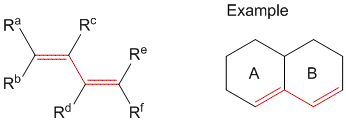
In the above example, it can be seen that one of the double bonds belongs to ring A while the other double bond belongs to ring B, hence making the double bond heteroannular. Since both double bonds are trans with respect to substituents making the diene a transoid diene. In general, heteroannular dienes are transoid. If the diene is not a part of a ring then it is just transoid.
2] Cisoid diene / Homoannular diene / cyclic diene: This type of diene involves the conjugation of two cis dienes. Since the double bonds are cis to each other, the molecule often tends to form a closed ring system and therefore also called a cyclic or homoannular diene. The base value for homoannular diene system is 253 nm according to the Woodward-Fieser rules. Examples of homoannular dienes are shown below.
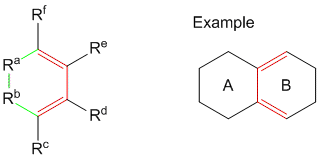
In the above example, it can be seen that both the double bonds belong to ring B making this type of diene a homoannular diene. Since both double bonds are cis with respect to substituents making the diene a cisoid diene. In general, homoannular dienes are cisoid. If the diene is not a part of a ring (i.e. the green bonds do not exist) then it is just a cisoid diene.
Important Note- If a molecule has both a homoannular diene and a heteroannular diene as the example 5 in the sample problems, then you must use the homoannular diene as the core chromophore.
Substituent Effects
Only the substituents attached directly to the double bond diene systems can influence the ultraviolet visible absorption of the molecules. If the substituents are not directly attached to the carbons of the diene system, it will not affect the UV-Visible absorption spectrum of the molecule (as shown below).
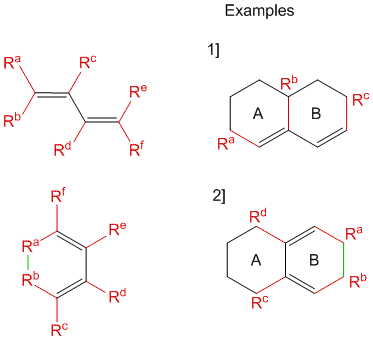
The figure above highlights possible substituents in red given by the different -R groups. In the above examples 1 and 2, assignment of substituents must be given to all the atoms which are directly connected to the diene. Hence even though the structure has no substituents, the core carbon atoms have yet to be considered as alkyl-substituents. Hence in example 1, there are 3 alkyl substituents while in example 2, there are 4 alkyl substituents.
If one sees down the list of substituents an interesting factor in affecting the absorbance is whether the substituent directly has a heteroatom (with lone pairs) linked to the conjugated diene system. Below is the list of possible substituent effects.
| Substituent | Influence | |
| -R (Alkyl group) | + 5 nm | |
| -OR (Alkoxy group) | + 6 nm | |
| -X (-Cl, -Br, -halogen) | + 10 nm | |
| -OC(O)R (Acyloxy/Ester) | + 0 nm | |
| -SR (Sulfide) | + 30 nm | |
| -NR2 (Amine) | + 60 nm | |
| – C=C (double bond extending conjugation) |
+ 30 nm | |
| – C6H5 (Phenyl group) | + 60 nm |
Important Note- In case of double bond extending conjugation such as those shown in example 4 and example 5 in the sample problems page, the substituents on the extended double bond must also be counted for the calculation.
Other Contributors
1] Exocylcic Double Bonds
Exocyclic doube bond by definition is a double bond where one of the participating carbon atoms is a part of a ring, while the other carbon atom is not part of the same ring. From the name we can understand that exo-cyclic would stand for a double bond outside the ring and endo-cyclic would stand for a double bond within the ring.
For each exocyclic double bond, we must add +5 nm to obtain the λmax. Below are a few examples as to what are exocyclic and what are endocyclic double bonds.
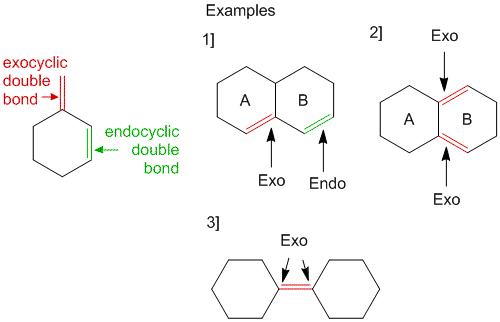
The above figure differentiates between exocyclic (shown in red) and endocyclic (shown in green) double bonds.
- In example 1, the double bond present within ring A is exocyclic to ring B as it is attached to an atom which is shared between ring A and ring B, while the double bond present in ring B is not connected to any ring A atoms and is within just one ring, hence making it endocyclic.
- In example 2, both double bonds are present within ring B with connections to shared carbon atoms with ring A, making both the double bonds exocyclic.
- In example 3, there is a single double bond which is exocyclic at two points to two different rings. In such a case, the influence would be 2 times + 5 nm (i.e + 10 nm).
Note: Double bonds which are common to two rings are endocyclic. Below we give an example of a double bond which although has carbon atoms shared between two rings (A and B), it is considered endocyclic as at any given time the double bond will only belong to one ring.
2] Solvent effects
Since the conjugated diene base is relatively non-polar, contribution due to different solvents is very minor and can be ignored in most cases.
Fieser-Kuhn Rules
Woodward-Fieser rules for dienes work well for conjugated systems with less than 4 double bonds in . For molecules having more than 4-double bonds, one must use the Fieser-Kuhn rules to determine the λmax. Check out this post for Fieser-Kuhn Rules to Calculate Wavelength of Maximum Absorption (Lambda-max) of Polyenes (with Sample Problems) to learn how to use these rules.
Problems to Use Woodward-Fieser Rules for Calculating the λmax of Dienes.
Check out the page for sample problems using Woodward-Fieser rules to calculate the λmax of dienes. Also check out the page on the Woodward-Fieser rules for Conjugated Carbonyl Compounds.
Books on Analytical Chemistry and Spectroscopy
Check out these good books for analytical chemistry and spectroscopy
References
- Woodward, R. B. Structure and Absoprtion Spectra. III. Normal Conjugated Dienes. J. Am. Chem. Soc. 1942. 64(1), 72-75.
- Woodward, R. B. Clifford, A. F. Structure and Absoprtion Spectra. II. 3-Acetoxy-Δ5-(6)-nor-cholestene-7-carboxylic Acid. J. Am. Chem. Soc. 1941. 63(10), 2727-2729.
- Fieser, L. F., Fieser, M., Rajagopalan, S. Absorption spectroscopy and the structures of the diosterols. J. Org. Chem. 1948. 13(6), 800-806.
- Spectroscopic Determination of Organic Compounds, 5th Edition, Silverstein, Bassler, Morrill 1991.
- Kalsi, P. S. Spectroscopy of Organic Compounds. 6th Edition, New Age International Publishers, New Delhi, 2004.
- Glagovich, N. Woodward Fieser Rules for Dienes. [Online]http://www.chemistry.ccsu.edu/glagovich/teaching/316/uvvis/diene.html (Accessed on July 27, 2012).
- Author Unknown. Michigan State University – Department of Chemistry. Emperical Rules for absorption wavelengths of conjugated systems. [Online]http://www2.chemistry.msu.edu/faculty/reusch/VirtTxtJml/Spectrpy/UV-Vis/uvspec.htm (Accessed on July 27, 2012).

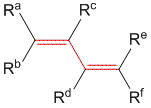

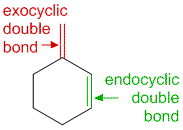

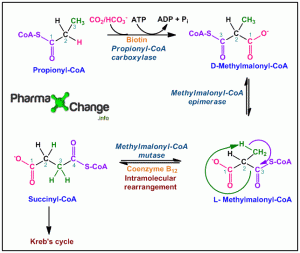

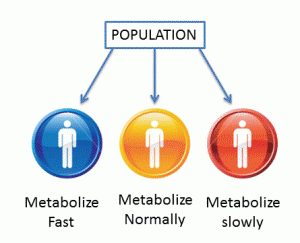
differenciate between phenanthrene and anthracene on basis of woodward rule
Thank you very much.
Aslam-o-Alykum:
i’m student of MSc chemistry … i need basic points of woodword rules….
further there implementation for lamda max.
Basic method how to find lamda max.
Can you provide me difference between Transoid and Heteroannular diene with example(imp for me)…???
Thnk u very much.
Very helpful
Very helpful but please explain double Bond extension with exocyclic double bond with in a ring system
wow yrr!! too good…..you taught me the basic diff. b/w endo & exo-cyclic doube bond.
hii sir please explain me
it very helpful
how to calculate lambda max value for this compound 3,5-diacetyl-1,4-dihydrolutidine
The information provided was so meaningful
It is good for every undergraduate chemistry student.
it will be super helpful to put information into writing
Thanks a lot
pls what is the lambda max of
1,4-dimethylcyclohept-1,3-diene
Should be ~273 nm based on these rules. Check out the sample problems to learn how to get this answer.
Wow u r responding . great
U r always seeing the respond of others
Thnx Akul for A lot of informations
Hello Akul,
how do I manage to calculate ?max of structures like Hypericin, Vitexin or Asarone ?
hello akul hope u wil fine.
akul i need some examples like digoxin morphine etc others natural products in which the lambda max are calculated on basis of woodward fischer rules
i dont understand and cant solve manually
plz need 10 examples of natural simple structre products
plz solve if u understand this rule….. i am waitng plz
Hi Aziz,
If you click here we have many examples of solved structures using woodward fisher rules. Please check them out
hi akul can u help me identifying some examples from alkaloids,flavonoids,terpenes and glycoside these are the organic groups from natural products on which these woodward’s fisher rules acts?
thanx
Hi Hina,
Lets take it one by one:
1) Alkaloids and flavanoids- generally aromatic compounds and therefore woodward fieser rules cannot be applied here.
2) terpenes- there are many examples where fieser-kuhn rules can be applied (click here). If the terpene is cyclic you can apply woodward fieser rules.
3) glycosides- the glycone part of these generally does not have a chromophore, and thus it would depend on the aglycone. If the aglycone is aromatic these rules cannot be applied.
I hope this helps.
Please be good enough to send me a tutorial regarding calculation of maximum wavelength
Hi Kinduri,
You can check out some of the Sample Problems to learn about the calculation for wavelength of maximum absorption (if that is what you meant). These articles are the tutorial.
hello its really a wonderfull articc thoughhh i wanna clarifyy my dobt regardingg the wavelength of benzaldehyde
Hi Manu,
Please be specific about what your doubt is. To be honest you cannot treat benzaldehyde as if it was a polyene. There are separate rules for aromatic compounds.
hi..if possible could u give me ur email address..coz i have made some question and i don’t know if i did it correctly..so could u please check my work and correct me..so that way i think it will improve my understanding..plus i don’t know the name of the compound..and last could u explain about ?,? coz i don’t know how to determined it..
TQ..
hi WaN,
I am sorry, I do not give my e-mail address on comment boards. You could contact me over facebook through the PharmaXChange group with your problem and I could take a look at it.
it is very helpful to me and clarify my most of doubt ..thank you very much
thank you so much
its helpfull
I really would like to thank u big time , i have my mid term advance chemistry exam tomorrow and this helped me so so much
Thank u very very much
Hi, I am glad it was very helpful to you. Please remember to share the link with your friends and like it on facebook or +1 on Google Plus.
hiii !!! can u plzz tell me the concept of calculating no. of ring residues in calculation of wavelength max.
Hi Akshay,
take a look at some of the example problems for Woodward-Fieser rules. These problems should help you clarify doubts about ring residues. In general ring residues are nothing but alkyl groups attached to the conjugated system which are part of the ring. For example, in the above article the substituent effect, Ra, Rb, Rc, and Rd are ring residues in the examples 1 and 2.
hello can you explain what the time homoannular diene have 2 or more exocyclic double bond?
Hi tre,
a homoannular diene would have a base absorbance of 253nm. If there are two exocyclic double bonds to this it would be 2 x +5 nm i.e. 10 nm. The maximum absorbance would therefore be at 253+10 = 263 nm. You must also take in to consideration the number of substituents in the system. Check out the Sample problems for calculating lambda max.
it helped me a lot.plz give some xmplz to calculate lambda max.
really helpfull article.it helped me a lot.plz also give some examplez to calculate lambda max.
Hi, Please check out Sample problems based on Woodward-Fieser Rules. That should be helpful.
hi, this article is helpful. But still I encounter difficulty in determining ring residue in complex structures with many ring on in. Can you give explanation about it? If one structure has double bond inside non aromatic ring (outside the base ring), will it include to the calculation of ring residue? thanks
Hi Dinar,
I appreciate you liking the article. Make sure to +1 on Google Plus and like/share on facebook. As far as your doubt is concerned, as structures get more complex it is possible you might see multiple lambda max for different absorbance species. Check out the Sample problems using Woodward-Fieser rules, see if a solved problem helps you find your solution. Otherwise you can post a comment on that page referring to a sample problem and specifying the exact structure there so that I can help you. It is difficult to visualize what you are referring to with the description you have provided.
Alternatively you can provide the IUPAC name of a structure or even the CAS number which will help me understand your problem better.
Thanks for the article. Really helpful
can u xplain wat exactly r transoid compounds ? how the 2 double bonds r trans to each other ….????
@umanshi: Unlike conventional nomenclature of trans and cis here transoid and cisoid has a slightly different meaning. In conventional nomenclature we assign trans and cis based on substituents. Here transoid and cisoid is with respect to the double bonds of the dienes. So to differentiate between the two: in case of a transoid diene, the double bonds form a more linear structure, while a cisoid double bond forms a more closed structure.
can u explain about endo and exocyclic double bond?????
Read the article above and my comment… it should be a good explanation. Also check out the sample problems. If you still have doubts ask more specific question about it.
endo cyclic double bond means the double bond within the ring and exo cyclic double bond means the double bond attach to the carbon of out side of ring